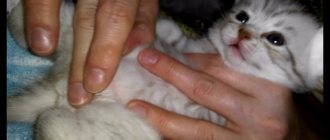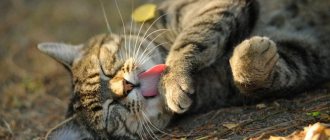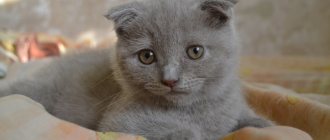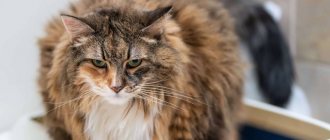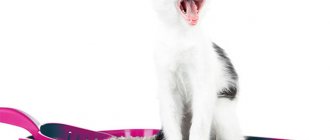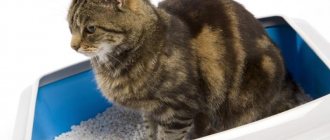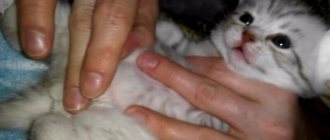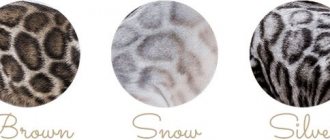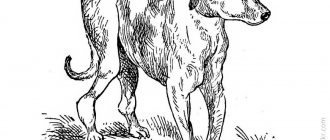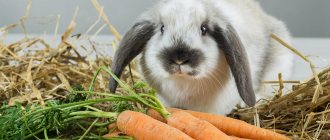Cat owners often have to deal with various health problems with their pets. The lion's share of diseases occurs in the gastrointestinal tract; representatives of the cat family especially often suffer from digestive disorders such as diarrhea or diarrhea. In most cases, bowel dysfunction does not pose a threat to the pet’s life and does not require drug therapy. However, in some cases, frequent loose stools may signal the development of a serious illness. Especially if there is blood in the stool, the animal’s condition deteriorates sharply, an upset stomach is accompanied by vomiting, the temperature rises, etc. In this case, it is important to know what to do and how to properly treat diarrhea in cats.
What is diarrhea in cats
Diarrhea (diarrhea) is not an independent disease; the condition is a signal of the presence of certain health problems in the cat. We are talking about dysfunction of the digestive tract, which is accompanied by excessive loss of fluid, pain in the abdomen, nausea, vomiting, weakness and loss of appetite. In cats, frequent loose stools are caused by increased intestinal motility, provoked by irritation of the intestinal mucosa by pathogenic bacteria or toxins.
Along with frequent defecation, the animal behaves restlessly, experiences discomfort, and often cannot find a place for itself. Despite the fact that in the vast majority of cases, a disorder of the digestive system does not pose a threat to the cat’s life, it is important to understand that prolonged diarrhea can lead to dehydration and can cause the death of the pet. It is extremely important to correctly recognize the symptoms of the disorder and promptly help the animal on your own at home or in a hospital.
Why does a kitten have problems with stool?
Newborn animals have difficulty defecating if the cat does not care for them properly. Problems can also arise in cases where kittens are cared for by humans, if the owner does not follow the rules. After feeding, it is necessary to massage the belly and groin area; To do this, it is recommended to use cotton swabs with soft bristles.
Older kittens fed solid food may suffer from digestive problems for several reasons.
Severe stress can cause constipation.
If the kitten has recently been separated from its mother, moved to a new place of residence, a visit to the veterinarian, or aggression from another animal can cause severe nervous tension, due to which bowel movements will temporarily disappear. Most often, the duration of absence of stool in such a situation does not exceed 2-3 days.
Early weaning from the cat is possible.
In such a situation, the cub greatly misses its mother and lacks her company. There may be no stool for up to 4-5 days, after which the small cat must poop. The situation is considered normal. You should be wary if bowel movements do not begin even after.
Errors in diet planning.
A sudden change in diet or excessive amounts of protein foods often leads to constipation.
Constipation occurs in animals infected with helminths.
Due to parasites, the functioning of the gastrointestinal tract is disrupted, which leads to intestinal blockage and deterioration of peristalsis. At the same time, the animal constantly scratches its butt on the carpet or other rough surface and may become too restless.
Symptoms of diarrhea
The symptoms of diarrhea are pronounced, the condition involves a frequent urge to empty the intestines, while the volume of a single bowel movement is less than usual, and the consistency is liquid. In addition, among the most common symptoms it is worth noting:
- acts of defecation – more than 3 times per day;
- watery, unformed stools;
- fecal incontinence, urgent urge to defecate;
- the color of the feces is light with shades of yellow, green, red if there is diarrhea with blood, and even black if the animal has damage to internal organs.
In addition, vomiting, painful spasms, lethargy, apathy and loss of appetite and other symptoms are often added to the existing picture. It is extremely important to recognize the symptoms in time and identify the root causes of the painful condition in order to understand what to do and what kind of help the cat needs.
Accustoming to adult food and litter box
How often kittens poop at 1 month is easier to determine, since now this process becomes more pronounced. This happens because at approximately this age, that is, at 3-4 weeks, pets begin to be switched to more solid food. Consequently, the process of defecation also becomes more complex and organized.
At the same time, it is necessary to accustom the baby to the tray. This is how you need to act right from the first emptying, otherwise it will be more difficult to do this in the future.
Monitor your pet's behavior carefully. Usually, before the process of defecation, the behavior of animals acquires certain features. Their so-called “search activity” is activated. They can rush around the room, look for a suitable place to relieve themselves, sniff the space around them and, finally, scratch their paws on the floor.
This is how most kittens behave. However, there are also “quiet people” who silently do their business somewhere in the far corner under the bed. So be careful.
Causes
The most common cause of problems with the digestive tract is a change in the cat's usual diet. If frequent bowel movements occurred during the introduction of changes in diet, we can say with confidence that the cause of the disease lies precisely in this. In this case, indigestion can be cured without special therapy. All you need to do is return to your usual food. However, the causes of digestive disorders in cats are not limited only to errors in nutrition; a number of household factors can provoke a painful condition:
- unbalanced diet - the presence in the pet’s diet of raw fish, dairy products, fatty foods, which can cause digestive problems;
- too large portions or frequent feeding;
- transition from natural food to special food or vice versa;
- low-quality water, a change in its usual composition can affect the functioning of the gastrointestinal tract;
- food poisoning: a pet may suffer from consuming spoiled food that has expired;
- individual intolerance to any product, allergies;
- dysfunction of the digestive tract can be caused by medications; manufacturers of veterinary drugs often list diarrhea in the list of side effects;
- postoperative period;
- postpartum rehabilitation and the period of gestation are also often accompanied by gastrointestinal disorders.
Frequent urges to defecate may be caused by an unstable emotional state of the cat. An experienced stressful situation, unfavorable home conditions, excitement, fear, the appearance of other pets in the house, long-term separation from the owner, the arrival of guests, or moving can cause diarrhea. These factors should not be a cause for concern; usually, special treatment is not required, the pet recovers on its own immediately after the disappearance of the traumatic factor.
At the same time, the cause of diarrhea with blood in a pet (or without bloody discharge) may lie in the presence of life-threatening diseases:
- salmonellosis, E. coli infection and other bacterial infections;
- diarrhea and vomiting in a cat with white foam can be caused by viral diseases, including the so-called feline leukemia, rotavirus, panleukopenia, etc.;
- the causes of green diarrhea in a pet can be a consequence of various liver diseases, including pancreatitis;
- diarrhea in cats is caused by pathologies of the digestive system of various etiologies, including partial or complete intestinal obstruction;
- intoxication of the body that developed as a result of complex drug therapy or caused by severe poisoning;
- metabolic disorders, including diabetes;
- parasitic lesions of the body - roundworms, helminthic infestations, worms;
- oncology;
- pathologies of the urinary system;
- fungal infections (mycoses).
Separately, it is worth noting the causes of vomiting with white foam with frequent acts of defecation; their nature is most often physiological, thus the pet independently gets rid of undigested food and toxins. In the absence of accompanying symptoms that aggravate the animal’s health, special treatment is not necessary.
Preventing constipation and diarrhea
You've already learned how often kittens poop and how to care for them. A loving owner should also take care of preventing problems with bowel movements. To do this you need:
- comb the animal regularly so that excess hair does not clog the intestines when licking;
- give kittens phytomines to cleanse the intestines;
- feed your pet a variety of foods, using foods rich in fiber;
- give space for your pet’s active life, which improves intestinal motility;
- contact your veterinarian in time.
Types of diarrhea in cats
Depending on the causes of the eating disorder, stool takes on different colors, textures and smells. Based on the analysis of these parameters, it is possible to draw a conclusion about the presence of a particular disease and determine a course of treatment at home.
Classification of diarrhea according to consistency and the presence of foreign impurities in the stool:
- liquid diarrhea, the presence of vomiting most likely indicates food poisoning;
- the presence of mucus in stool indicates damage to the large intestine;
- blood in the stool indicates the infectious nature of diarrhea, the presence of parasites, or indicates damage to internal organs.
Depending on the color of the stool, the following types of diarrhea are distinguished:
- yellow stool – incomplete digestion of food eaten;
- black color - indicates the presence of internal bleeding (you should seek emergency veterinary help or call a veterinarian at home), may also be a consequence of taking medications containing iron or indicate an excessive meat diet;
- green color - with a high degree of probability indicates the consumption of spoiled foods that provoke rotting processes in the intestines; you can treat green diarrhea yourself;
- white color - indicates the presence of problems in the biliary tract;
- orange color - the pet is experiencing severe intoxication and needs emergency help.
What treatment is prescribed?
To stabilize the situation, it is recommended to adjust the animal’s diet by including steamed food in its diet.
If stool that is too liquid or too hard is a consequence of poor nutrition, the first thing you should do is review your pet’s diet. When feeding natural food, it is recommended to diversify the menu with steamed vegetables and fruits, to teach the cat to eat special cat grass, which not only normalizes digestion, but also saturates the body with vitamins and essential elements. If your pet is accustomed to dry food, it is important to ensure that clean and fresh water is freely available.
For constipation, medications with a laxative effect are prescribed, for example:
How to determine that a kitten wants to go to the toilet?
Many inexperienced owners are afraid that they will not be able to determine when the kitten wants to poop. If a cat scratches the surface with its paws, the owner should transfer it to the tray as soon as possible. Usually the kitten understands from the first time what is required of him.
Another way to determine that a cat wants to go to the litter box is this behavior when he seems to sniff around, as if looking for a place. It is also worth looking at the pet’s eyes; if the owner sees that the cat seems to be glazed over, then he is definitely thinking about his goal. As soon as the cat begins to show such signs, it means that she wants to poop.
How often should a three month old kitten go to the toilet?
From the age of one month, the kitten switches to nutritious food. As a rule, up to three months his nutritional diet and, accordingly, the nature of his feces change. The feces become more shaped. You can understand how many times a day a kitten should go to the toilet by the nature of the baby’s diet. If his food includes plant fiber, then this process will occur more often, but if the food contains a large amount of protein, then less often. The most important thing during this period is that the cat poops every day, and that the feces are free of blood, mucus, and undigested food.
How to treat blood in stool
We told you what to do before going to see a doctor, now let’s talk about how the treatment will proceed. Treatment for this pathology may include the following:
- injections of antibiotics to reduce inflammation in the cat's intestines;
- prescription of antibacterial, anti-inflammatory, antihistamine and other drugs;
- surgery to remove polyps and cancerous tumors;
- use of anthelmintic drugs for helminthic infestation;
- elimination of the inflammatory process in the paraanal glands: drainage, treatment with medicinal solutions;
- transferring the animal to a special therapeutic diet;
- prescribing laxatives to loosen stools and facilitate bowel movements;
- installing IVs if there is a risk of dehydration;
- inserting suppositories with medicines and sea buckthorn oil into the cat’s anus;
- installation of an enema for emptying and cleansing the intestines of feces.
We invite you to familiarize yourself with: The largest cats in the whole world A treatment regimen, medications and a therapeutic diet should be prescribed by a doctor after making a final diagnosis.
Self-medication in this case is unacceptable! It can lead to serious deterioration of the pet's condition and death.
Form
The shape of your stool can also tell you a lot about your internal health. Thin stool (resembling a pencil) should alert you. Perhaps some kind of obstruction is blocking the passage in the lower part of the intestine or there is pressure from the outside on the colon. This could be some kind of neoplasm. In this case, it is necessary to perform a colonoscopy to exclude a diagnosis such as cancer.
Hard and small feces indicate the presence of constipation. The cause may be an inadequate diet that excludes fiber. You need to eat foods high in fiber, do physical exercise, take flaxseed or psyllium husk - all this helps improve intestinal motility and ease stools.
Stool that is too soft and clings to the toilet contains too much oil. This indicates that the body does not absorb it well. You may even notice oil droplets floating. In this case, it is necessary to check the condition of the pancreas.
In small doses, mucus in the stool is normal. But if there is too much of it, it may indicate the presence of ulcerative colitis or Crohn's disease.
Prices
| Name of service (price list incomplete) | Price |
| Appointment (examination, consultation) with a gastroenterologist, primary, therapeutic and diagnostic, outpatient | 1750 rub. |
| Prescription of treatment regimen (for up to 1 month) | 1800 rub. |
| Consultation (interpretation) with analyzes from third parties | 2250 rub. |
| Consultation with a candidate of medical sciences | 2500 rub. |
| Ultrasound of the abdominal organs (comprehensive) | 2900 rub. |
| Ultrasound of the retroperitoneal space (and retroperitoneal lymph nodes) | 1400 rub. |
| Ultrasound of the gallbladder | 1400 rub. |
| Ultrasound of the abdominal organs (comprehensive) | 2900 rub. |
| Ultrasound of the liver | 1600 rub. |
| Ultrasound of the spleen | 1600 rub. |
| Diagnosis of Helicobacter pylori infection (HELPIL test) | 1200 rub. |
| Colonoscopy | 5050 rub. |
| Biopsy during endoscopic examination (1 biopsy) | 1000 rub. |
| Body composition assessment - bioimpedance analysis | 2150 rub. |
| Body composition assessment - repeated (bioimpedance analysis) | 1750 rub. |
| Esophagogastroduodenoscopy (EFGDS) | 3050 rub. |
